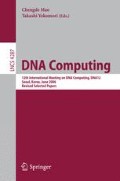Abstract
In this article we propose a formalization of protocols simulating the separation of molecules by gel electrophoresis. In our model, we introduce a new concept, namely, filtering by length – a direct formalization of the gel electrophoresis action. We also define a distributed computational model based on this action and on the splicing operation, called length-separating splicing test tube systems. We prove that these constructs, even with restricted size parameters, can simulate the Turing machines. We also discuss different natural restrictions and generalizations of the model which may be used to find efficient ways to realize DNA transformations in the laboratory.
Access this chapter
Tax calculation will be finalised at checkout
Purchases are for personal use only
Preview
Unable to display preview. Download preview PDF.
References
Csuhaj-Varjú, E., Kari, L., Păun, G.: Test tube distributed systems based on splicing. Computers and AI 15(2–3), 211–232 (1996)
Head, T.: Formal language theory and DNA: an analysis of the generative capacity of specific recombinant behaviors. Bulletin of Mathematical Biology 49(6), 737–759 (1987)
Hopcroft, J., Motwani, R., Ullman, J.: Introduction to Automata Theory, Languages, and Computation, 2nd edn. Addison-Wesley, Reading (2001)
Margenstern, M., Rogozhin, Y.: A universal time-varying distributed H system of degree 2. Biosystems 52, 73–80 (1999)
Păun, G., Rozenberg, G., Salomaa, A.: DNA Computing: New Computing Paradigms. Springer, Heidelberg (1998)
Rozenberg, G., Salomaa, A.: Handbook of Formal Languages, vol. 3. Springer, Heidelberg (1997)
Verlan, S.: Communicating Distributed H Systems with Alternating Filters. In: Jonoska, N., Păun, G., Rozenberg, G. (eds.) Aspects of Molecular Computing. LNCS, vol. 2950, pp. 367–384. Springer, Heidelberg (2003)
Verlan, S.: Head Systems and Applications to Bio-Informatics. PhD thesis, University of Metz, France (2004)
Verlan, S.: A boundary result on enhanced time-varying distributed H systems with parallel computations. Theoretical Computer Science 344(2-3), 226–242 (2005)
Author information
Authors and Affiliations
Editor information
Editors and Affiliations
Rights and permissions
Copyright information
© 2006 Springer-Verlag Berlin Heidelberg
About this paper
Cite this paper
Csuhaj-Varjú, E., Verlan, S. (2006). Length-Separating Test Tube Systems. In: Mao, C., Yokomori, T. (eds) DNA Computing. DNA 2006. Lecture Notes in Computer Science, vol 4287. Springer, Berlin, Heidelberg. https://doi.org/10.1007/11925903_5
Download citation
DOI: https://doi.org/10.1007/11925903_5
Publisher Name: Springer, Berlin, Heidelberg
Print ISBN: 978-3-540-49024-1
Online ISBN: 978-3-540-68423-7
eBook Packages: Computer ScienceComputer Science (R0)

